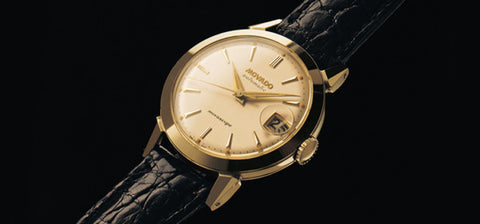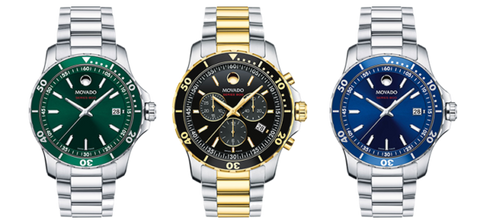The History of Movado: Swiss Tradition Meets American Modernism
Movado is a watch manufacturer that focuses on a unique modern art aesthetic, stripped down to a clean, elemental essence in its forms.
The company is part of the Movado Group , which played a major role in popularizing watches as a status symbol in the United States.
Movado was founded in La Chaux-de-Fonds, Switzerland, and moved its headquarters to the United States after being purchased by an American businessman.
The base design of Movado 's Museum Watch was unusual for a wristwatch.

In this article, we look at how Movado discovered and established its unique minimalist aesthetic.
The Art Deco Era: Movado's Early Watches
Movado's First Minimalist Wristwatch
A wealth of modernist styles
Movado 's Bold New Century

Calendoplan (with opening for magnifying the date)
The Art Deco Era: Movado's Early Watches
Movado's aesthetic is informed by modern art.
In the brand's early days, the Art Deco style was at its peak.
Movado Origins: Pioneering Firsts
In 1881 , the 19- year-old Achille Ditesheim founded a workshop for clock movements and pocket watches in La Chaux-de-Fonds, Switzerland.
In 1905 , he changed the name of his company from LAI Ditescheim & Freres SA to Movado .
Movado means "movement" in Esperanto.
The name Movado symbolizes the company's contemporary, international nature and forward-thinking design philosophy.
Around this time, Movado began to transition from pocket watches to wristwatches.
Shortly after the name change, the company released a watch with an original design.
The 1912 Polyplan is a watch with a tight-fitting rectangular case that curves around the wearer's wrist.
Movado's proven movement engineering and design foundation made it possible to design this caliber.

The polyplanar movement is spread over a plate with both ends sloping downwards.
This gives the movement three planes , hence the name "polyplan".
Its clever design allows it to fit perfectly into a case that was quite unusual for its time.
This watch was definitely ahead of its time.
This style of watch became popular among men after World War I.
Polyplan has a noticeable curvature to the watch, even when compared to later models from competitors.
Movado Art Deco Pocket Watch
In the 1920s , Movado began to explore new pocket watch designs inspired by modern art.

Pocket watches made during this period represent the height of the Art Deco era's modernist aesthetic.
For this reason, Movado decorates its pocket watches with opulent colors and playful, delicate enamel and gold-plated edges.
These stylized watches explored unconventional ideas not only in their form but also in their function.
For example, the Movado Ermeto is a slide pocket watch that closes to hide the face when the watch is in your pocket.
Later models have a mechanism for winding the screw by opening and closing the case.
Movado Ermeto Watches

Movado's first minimalist watch
The minimalist aesthetic that would become Movado's image was first adopted in the 1930s .
1930s : Movado Digital Watch
Movado Early Digital Display Watch

As a new challenge, in the 1930s the company released a line of digital watches.
These watches have no dial but rather an opening through which the wearer can read the time.
Movado digital watches have numbers that can be read by rotating metal discs that have numbers engraved on them.
Using the same method, I also made the calendar clock display the day of the week and date.
Because these discs took up a lot of space, the numbers displayed on the face of the disc were very small.
Despite these technical limitations, the collection showcased Movado's ingenuity in design and presentation.
Also, the very minimalist aesthetic of these early digital watches is a glimpse of things to come for Movado.
Movado's first museum watch , the Museum Watch

In 1948, Movado began production of its most iconic models, which cemented its brand.
In 1947, designer Nathan George Horwitt created the Museum Dial Watch.
This design simplifies the watch to its essentials, with even the smallest elements distracting from its functionality.
The Museum features a beautiful black face with the hands of the dial floating on it and a gold circle at the 12 o'clock position.
This gold circle indicates that the sun will be directly overhead at 12 o'clock.
The crystal extends almost to the edge of the case, with only a small edge visible.
The edges are perfectly circular and appear to float above the crown and thin, straight lugs.
At the time, the Museum Watch was a one-off model for the company.
This classic industrial design influences the aesthetic of Movado watches today with its timeless visual clarity.
Subsequent Movado designs have built on this foundation and evolved to meet demand for additional features.
Movado Elegant Calendar Watch

Around this time, Movado released a dressier collection of watches featuring complicated calendar functions.
Like most dress watches, these timepieces have thin, understated gold cases and leather straps.
Also, like the Museum Dial Watch and this Digital Watch, the crystal extends almost to the edge of the case.
The Calendomatic dial displays a wealth of information, including the month, date, hours, minutes and seconds.
It was also the first watch at the time to feature an automatic winding mechanism.
The Calendoplan also featured a calendar function and a seconds hand, but with a subtle cream and gold dial.
The date aperture has been enlarged so that it is small and unobtrusive.
Although the calendar is small, the wearer can easily read it when looking at the watch from the front.
During this period, Movado also began producing ultra-precise quartz watches, such as the Datron chronograph in 1970 .
Datron was Movado 's most popular product at the time.
The Datron line, known for its barrel-shaped cases, is still available today.
1970 Datron model

Movado's Modern American Revival
In 1983 , Movado was acquired by North American Watch Corporation (NAWC) .
The NAWC had an ambitious goal: to make luxury watches an American status symbol.
At a time when even the wealthiest Americans preferred to wear cheap watches, this was an ambitious goal for NAWC founder Gedalio Grinberg .
Even the Rockefellers wore watches that cost less than $ 20 .
To create a luxury watch that would appeal to Americans, Greenberg turned to contemporary art.
During the course of the Cold War, modern art was purchased as a Western, First World aesthetic, in contrast to Communist art.
In the late 1960s , Museum Watch creator Nathan George Howitt, a friend of Greenberg's, brought Movado to the attention of some of the most influential people in the watch industry.
Grynberg saw Movado as an opportunity to create a fresh, new, modern, art-based style for American watches.
To this end, Greenberg sought out many of Horwitt's contemporary art peers and contemporaries.
A wealth of modernist styles
After moving its headquarters to the United States, Movado became deeply involved in the American contemporary art scene.
Movado Artist Series
Greenberg became friends with Andy Warhol and created the Movado Artists series, featuring contemporary artists he met at the time.
The line is inspired by pop art, kinetic art, op art and street art.
For this series, Warhol designed Andy Warhol Times/5 .
This clock has five sides and features five landscape photographs of New York taken by the artist.
Therefore, all five dials show the same time.
Andy Warhol Times/5

James Rosenquist's "Elapse, Eclipse, Ellipse" consists of multiple movements, three board states and three sets of hands.
The faces of Rosenquist watches blend into one another and are encased in an intricate, convex sapphire crystal cover.
Yaacov Agam, a leading figure in the kinetic art movement, has designed 16 timepieces for Movado, including four wristwatches.
These are "Galaxy", "Love Star", "Multidimensional" and "Rainbow".
Instead of traditional hands, these clocks use superimposed transparent discs painted with colorful shapes.
"Bill-time", the work of Max Bill, a pioneer of the Concrete Art movement, was a bit more traditional in design.
Movado is limited to 99 pieces

From the left: "Elapse, Eclipse, Ellipse," "Rainbow," and "bill-time."
Museum Watch's legacy lives on
At this point, Museum Watch's designer, Nathan George Horwitt, was about 90 years old.
He approached many watch companies over the years with this design, but ultimately felt that only Movado shared his vision.
And after working with Greenberg, he finally brought his vision for Museum Watch to life.
Horwitt's designs have been successfully featured in many art museums and design centres around the world.
And the gold dot on the Museum Watch became Movado's signature.
Even after Horwitt's death in 1990, Movado produced new versions of the Museum Watch.
In 1981, they released the Imperiale, a variation of the Museum Watch.
The Imperiale has a steel link strap rather than leather.
The gold dot motif is repeated on the upper part of the dial as well as on the strap.

Bold Takes Movado to the New Century
Continuing its pioneering approach to design, Movado has used new technology in the design of the MuseumWatch.
For example, the BOLD series uses ion deposition technology to allow the steel case to match the color of the leather strap.
New materials such as TR90 "memory plastic" will appear in new watches.
The BOLD series also includes a quartz movement chronograph that displays minimal information.
Small black markers separate the dial and subdials, with one number at the top of each subdial.

The Movado Edge was designed by Swiss artist and designer Yves Béhar.
Yves Béhar's designs often feature simple forms with patterned textures.
This watch has the same proportions as the original Museum Dial Watch, with a very narrow bezel and low-profile crown.
The design utilises Yves Béhar's signature texture, with radial grooves blending with the concave surface of the Edge.

Movado Chronograph Classics by Series 800
Many people find numbered indexes easier to read and prefer them, so we also make watches that are not minimalist.

The Series 800 offers styling that evokes the tonneau shape of the 1970s Datron.
This watch uses an extremely accurate quartz movement and the case is made from aluminum and steel.
Smartwatches: Movado's new digital watch
In the 2010s, Movado began producing smartwatches, including models with fully digital displays and some with analog dials.
All these watches are compatible with Android and iOS.
A joint project with HP, Movado Bold Motion features LED indicator lights around the bezel of the dial.
These lights will vibrate and alert you to phone calls.
These notifications can be enabled/disabled or prioritized from the watch app, allowing users to toggle between certain types of notifications.
On the BOLD, the dot is also an LED indicator and can be used in the app.
Movado Connect

Additionally, the analog dial smartwatches Bold Motion and Museum Sport Motion can sync the time with the user's smartphone.
Both watches have the basic features of a fitness watch, including a step counter that can be tracked via an app.
The fully digital display lines are Connect and Bold Connected II.
These are more like a typical smartwatch, with the smartphone and display fully integrated.
The app offers a variety of virtual dials modeled after Museum Watch, Movado Bold, and others.




